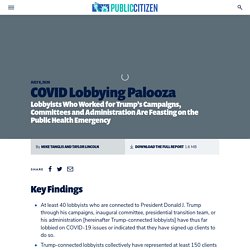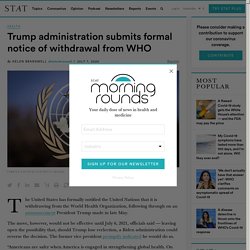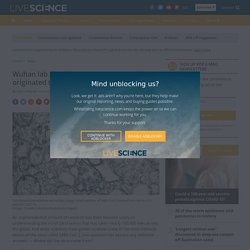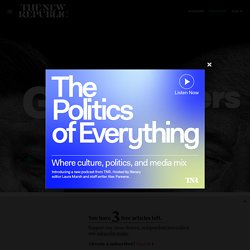

Oxford vaccine: How did they make it so quickly? Homepage - GHS Index. COVID Lobbying Palooza - Public Citizen. Key Findings At least 40 lobbyists who are connected to President Donald J.

Trump through his campaigns, inaugural committee, presidential transition team, or his administration [hereinafter Trump-connected lobbyists] have thus far lobbied on COVID-19 issues or indicated that they have signed up clients to do so.Trump-connected lobbyists collectively have represented at least 150 clients on COVID matters. Trump-connected lobbyists from a single firm (Brownstein Hyatt Faber Schreck) have represented at least 45 clients on COVID issues.At least 14 clients represented by Trump-connected lobbyists are working on COVID vaccines, therapeutics or tests.Twenty-seven clients of Trump-connected lobbyists have received federal COVID aid, totaling more than $10.5 billion. This consists of $6.3 billion in grants, $4.2 billion in loans and $67 million worth of support in the form of corporate bond purchases by the Federal Reserve.
Executive Summary – An employee of Trump’s National Security Council; Trump administration submits formal notice of withdrawal from WHO. The United States has formally notified the United Nations that it is withdrawing from the World Health Organization, following through on an announcement President Trump made in late May.

The move, however, would not be effective until July 6, 2021, officials said — leaving open the possibility that, should Trump lose reelection, a Biden administration could reverse the decision. The former vice president promptly indicated he would do so. “Americans are safer when America is engaged in strengthening global health. On my first day as President, I will rejoin the WHO and restore our leadership on the world stage,” Biden announced Tuesday on Twitter. advertisement STAT reached out to WHO Director-General Tedros Adhanom Ghebreyesus for comment, but received no reply.
But Jeremy Konyndyk, a fellow at the Center for Global Development, called the move “reckless and entirely unjustified.” “This is the end of an era of United States global health leadership,” he said. 60 agencias internacionales exhortan a una respuesta coordinada y oportuna para enfrentar la crisis económica y financiera desatada por la pandemia que amenaza con desestabilizar las finanzas de los países de menores ingresos. Obtenga una copia del reporte completo en NUEVA YORK, 9 de abril de 2020 – De acuerdo con un nuevo reporte del Grupo Interagencial sobre Financiamiento para el Desarrollo, liderado por las Naciones Unidas, los gobiernos deben tomar medidas inmediatas para hacer frente a los estragos económicos y financieros causados por la pandemia del COVID-19, y prevenir una crisis de deuda con efectos potencialmente devastadores.

El Informe del Financiamiento para el Desarrollo Sostenible 2020 propone una serie de medidas para paliar los efectos de la recesión global y la crisis financiera, en particular para los países de menores ingresos. Las recomendaciones se basan en la investigación y análisis del Sistema de Naciones Unidas, el Fondo Monetario Internacional, el Banco Mundial y más de 60 agencias de las Naciones Unidas y organismos internacionales.
La edición 2020 del Informe del Financiamiento para el Desarrollo Sostenible hace un llamado urgente para tomar las siguientes medidas: Wuhan lab says there's no way coronavirus originated there. Here's the science. An unprecedented amount of research has been focused solely on understanding the novel coronavirus that has taken nearly 150,000 lives across the globe.

And while scientists have gotten to know some of the most intimate details of the virus called SARS-CoV-2, one question has evaded any definitive answers — Where did the virus come from? Live Science contacted several experts, and the reality, they said, is that we may never know where this deadly coronavirus originated. Among the theories circulating: That SARS-CoV-2 arose naturally, after passing from bats to a secondary animal and then to humans; that it was deliberately engineered and then accidentally released by humans; or that researchers were studying a naturally-occurring virus that subsequently escaped from a high-security biolab, the Wuhan Institute of Virology (WIV) in China.
The head of the lab at WIV, for her part, has emphatically denied any link to the institute. Related: 13 coronavirus myths busted by science. Grim Reapers. As viral testing finally rolled out on a minute scale in the first week of March, the American public learned of pockets of community transmission of the disease all over the country—especially near Seattle and New York City.

Stock markets continued their steep slide. Some institutions, such as schools and nursing homes, shut down; the National Guard was dispatched to help enforce quarantine conditions in the viral hot spot of New Rochelle, N.Y. It was clear that little was being done at the federal level to quell the spread of the virus—and citizens increasingly felt desperately thrown back on their own limited resources to contend with the specter of a long-term, lethal pandemic. By the time of Trump’s March 12 special address to the nation, much of the American public already knew the awful truth: that the entire Trump administration strategy for protecting them from Covid-19, which rested on airport controls to keep the virus out of the country, was a nonstarter.